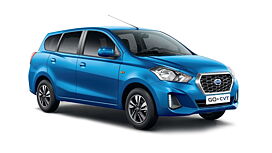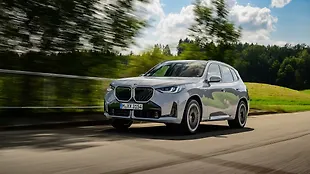What is it?

The cars you see in the pictures are the Datsun GO and GO+ facelift. Although from the outside they might not look too different as compared to the old car, underneath there are quite a few changes to shout about.
At first glance the biggest difference you spot on the new cars are the sporty looking 14 inch alloys, which just helps the car look more premium. Then you will also notice the new front bumper that is now sharply cut and the swept back headlamps that makes the car look more mature than before. You also get smart looking daytime running lights stacked vertically on either side of the bumper. Similar treatment has been given at the back, with the new bumper being the only major change. The smaller GO is the more balanced looking of the two because the GO+’s extended boot section looks a bit bulky when viewed in profile.

Under the skin Datsun have made structural changes to help both the cars comply with the crash test norms which are going to be in effect from next year. On the downside it has added a lot more weight as the updated cars are almost 100kg heavier. But the additional weight is a very small penalty to pay for much needed added safety.

How is it on the inside?

The insides of the GO and GO+ is a big step up over the old car. It actually gives you an impression of sitting inside a different car altogether. Gone is the crude dashboard of the old car and it is replaced by a thoroughly modern looking one. The hexagonal center console that is bordered by silver finish, looks attractive and the new 7-inch infotainment system lends it a modern look. The only difference between the Go and Go+ on the inside is the dual tone white and black dashboard on the latter which makes it feel even more airy. Welcome addition come in form of a glovebox (the old car had no closed storage) and they have also got rid of the old-school pull-type handbrake for a conventional one. There are plenty of storage spaces upfront – you get big door pockets, two cup holders, a big glovebox and two small cubbies next to the steering column. People sitting in the back aren’t that lucky as they only get slim seat back pockets as storage option. Surprisingly there isn’t a rear parcel shelf even in the top variant. Overall quality has improved drastically over the old car but you will still find some rough edges. You still find uneven panel gaps both in and out and stuff like the exposed metal lever for seat adjust doesn’t shout quality.

In terms of space, both cars remain unchanged. But thankfully they have ditched the bench seat upfront for two separate bucket seats. As a result they offer better bolstering and the lack of centre cushioning has also freed up some storage spaces. Although better, the seats are still a bit flat and don’t offer much lateral support. You also don’t get driver seat height adjust or steering adjust. Yet the driving position is quite good as you sit at a good height and the non-adjustable steering and the pedals are placed ideally for most heights. The large windows all-round gives good visibility, which is a boon while driving on crowded roads.

At the back you get the same flat yet wide bench, which can accommodate three in decent comfort but, what could have made it even better is a bit more knee-room. The bench itself offers good back support and there is more than enough headroom on offer. Like the front even at the rear you get fixed headrests, but they are placed low and won’t really help in avoiding whiplash injuries in case of a rear impact. Our test car came with faux leather seat covers which won't be part of the standard equipment. The USP of the Go + is that its the cheapest seven seater you can buy. The third-row though is cramped and best used as added luggage space.

The Go offers generous boot space at 256 litres, while the bigger Go+ has 347 litres with the third-row folded. While the Go can easily take weekends worth of luggage, the Go+ offers practicality as good as some estates. You can also fold the middle-row on the Go+ which gives and a humongous loading bay that is good enough even when you are shifting houses.

As compared to the earlier car, the new Datsun Go comes with additional features like Keyless entry, tachometer, a trip computer, a high-quality 7 inch capacitive touchscreen infotainment system that is Apple CarPlay and Android Auto enabled, all four power windows(old car just came with powered front windows)and electrically adjustable ORVMs in the T variant. In the top T option variant you get stuff like 14 inch alloy wheels, LED daytime running lamps and rear wash and wipe over the T variant. The good news continues, as Datsun now is offering two airbags, ABS with EBD and brake assist as standard across the range.
How does it drive?

Both the Go and the Go+ is still powered by the same 1198cc three cylinder petrol motor as the old car. Making identical 67bhp and 104 Nm torque as before, we expected it to perform similar to the old car. But to our surprise that wasn't the case and it actually felt slower. At low engine speeds there isn't much torque and this motor hesitates below 2000rpm to gain momentum quickly. Mid-range is where it feels the best but still it doesn't feel as effortless as a 1.2-litre motor in a light car should. As a result to get the most out of this motor you have to do a lot of gearshifts, which brings forth it's another drawback. The gearbox is notchy and you have to put in a lot of effort to shift. Even the gates aren't well-defined and this gearbox doesn't like quick shifting.

Despite its budget credentials the ride quality on the Go and Go+ is actually quite good. It mostly feels supple and the dampers do a good job of keeping the car settled even on uneven road surfaces. Where the Go struggles a bit is over sharp bumps where the suspension tends to crash and at highway speeds there is some up and down motion over undulating surfaces. At slow speeds the Go or the Go+ is extremely easy to drive thanks to the great visibility and light steering. But it isn't a sporty car and it rolls quite a bit when you start cornering enthusiastically. It not having an antiroll bar doesn't help its cause, nor does the steering which isn’t direct and has quite a bit of dead-zone around the centre ahead position. Drive it in an unhurried manner, then the Go feels well planted with safe and predictable manners. The brakes do a good job of stopping the car and the added safety net of standard ABS boosts confidence further.
Should I buy one?

The Datsun Go and Go+ should cost around Rs 30,000 more than the outgoing car and considering the amount of extra equipment on offer it comes across as a good deal. The fact that they have improved on the shortcomings of the old car and seem to have addressed safety issues thanks to structural changes and by giving airbags and ABS as standard, makes it a more peace of mind buy. The Go or Go+ works if you want a car that is well equipped, has a big boot and is more practical that any hatch at this price. But even now, it doesn't feel as premium as some of its competitors like the Tata Tiago or the Maruti Celerio. Then there is the engine and gearbox combo, which doesn't come across as well engineered as it should in a car that is coming out in 2018.
Where does it fit in?

The Datsun Go and Go+ goes up against cars like the Renault Kwid 1.0 litre, Tata Tiago and the Maruti Celerio.
Pictures by Kaustubh Gandhi

![Datsun GO [2014-2018] Exterior Datsun GO [2014-2018] Exterior](https://imgd.aeplcdn.com/642x361/cw/ec/36446/Datsun-GO-Exterior-137931.jpg?wm=1&q=80)
![Datsun GO [2014-2018] Front View Datsun GO [2014-2018] Front View](https://imgd.aeplcdn.com/642x361/cw/ec/36446/Datsun-GO-Front-view-137939.jpg?wm=1&q=80)
![Datsun GO [2014-2018] Music System Datsun GO [2014-2018] Music System](https://imgd.aeplcdn.com/642x361/cw/ec/36446/Datsun-GO-Music-System-137981.jpg?wm=1&q=80)
![Datsun GO [2014-2018] Music System Datsun GO [2014-2018] Music System](https://imgd.aeplcdn.com/642x361/cw/ec/36446/Datsun-GO-Music-System-137949.jpg?wm=1&q=80)
![Datsun GO [2014-2018] Music System Datsun GO [2014-2018] Music System](https://imgd.aeplcdn.com/642x361/cw/ec/36446/Datsun-GO-Music-System-137980.jpg?wm=1&q=80)
![Datsun GO [2014-2018] Music System Datsun GO [2014-2018] Music System](https://imgd.aeplcdn.com/642x361/cw/ec/36446/Datsun-GO-Music-System-137963.jpg?wm=1&q=80)
![Datsun GO [2014-2018] Wheels-Tyres Datsun GO [2014-2018] Wheels-Tyres](https://imgd.aeplcdn.com/642x361/cw/ec/36446/Datsun-GO-WheelsTyres-137944.jpg?wm=1&q=80)
![Datsun GO [2014-2018] Exterior Datsun GO [2014-2018] Exterior](https://imgd.aeplcdn.com/642x361/cw/ec/36446/Datsun-GO-Boot-Space-137989.jpg?wm=1&q=80)























